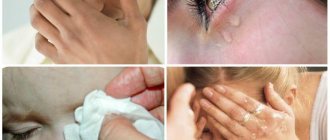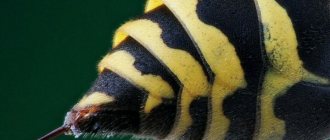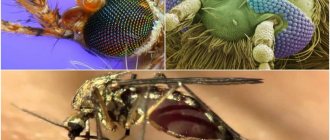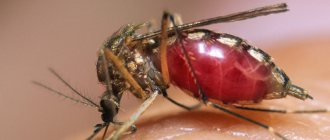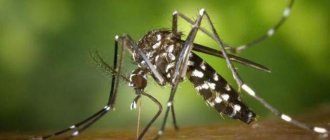- Wild animals
- >>
- Insects
The malaria mosquito is the most dangerous representative of the mosquito family and the hero of various frightening stories. It lives in many countries and is capable of transmitting not only allergens, but also malaria, which causes the death of up to half a million people every year. In our latitudes, many do not know what this creature with a tarnished reputation looks like, and often mistake the harmless long-legged mosquito for malarial, while it is absolutely harmless to humans.
Origin of the species and description
Photo: Malaria mosquito
The malaria mosquito is a dipterous insect, an obligate bloodsucker from the suborder Long-whiskered, which is a carrier of malarial plasmodia, which are considered the most dangerous parasites for humans. The Latin name for this species of arthropod is Anopheles, which translates as harmful, useless. There are 400 varieties of Anopheles, many of them are capable of transmitting malaria, as well as being the main host for a number of other dangerous parasites.
Video: Malaria mosquito
Several fossil varieties are known from Oligocene and Dominican amber deposits. Some historians believe that malaria was the main cause of the fall of the Western Roman Empire in the fifth century. At that time, epidemics broke out in the coastal regions of Italy. The draining of numerous swamps and the construction of new roads resulted in almost constant brutal malaria for the inhabitants of Rome. Hippocrates also described the symptoms of this disease and associated the onset of malaria epidemics with natural conditions.
Interesting fact: Malaria mosquitoes look at the world through the prism of infrared rays, so they are able to find warm-blooded animals and people even in pitch darkness. In search of an object to receive a portion of food - blood, these arthropods can fly over distances of up to 60 kilometers.
Appearance and features
Photo: What does a malaria mosquito look like?
This dangerous representative of the mosquito family has an oval-shaped body, the length of which can reach 10 mm. The eyes of the malaria mosquito are scalloped, consisting of a huge number of ommadityae. The insect's wings are oval, highly elongated, have many veins and two brown spots. The mosquito abdomen consists of a dozen segments, the last two of which are the external part of the genital apparatus. Antennae and antennae located on the small head serve for touch and smell recognition. The mosquito has three pairs of legs and halteres attached to the chest.
The mouth of an arthropod is a real piercing and cutting instrument. The mosquito's lower lip is a thin tube that serves as a support for sharp stilettos. With the help of two pairs of jaws, the arthropod very quickly breaks the integrity of the victim’s skin and sucks blood through the tube of the lower lip. In males, due to the nature of their diet, the piercing apparatus is atrophied.
Even an ordinary person, knowing some features, can visually determine whether in front of him is a carrier of dangerous parasites or an ordinary squeaking mosquito.
Distinctive features:
- In dangerous insects, the hind legs are much longer than the front ones, while in ordinary mosquitoes they are the same;
- the back part of the Anopheles body is raised, and the squeaks are located strictly parallel to the surface.
Scientists identify a number of other differences that can only be noticed upon detailed examination by a specialist:
- Anopheles wings have scales and are covered with brown spots;
- The length of the whiskers located next to the lower lip is longer in malaria mosquitoes than in ordinary representatives of the mosquito family.
Individuals living in hot countries are light in color and small in size; in cool areas, dark brown mosquitoes with a larger body are found. The larvae of different types of Anopheles also have differences in color and size.
Interesting fact: Before committing a bite, the malaria mosquito makes movements similar to a kind of dance.
Now you know what a malaria mosquito looks like. Let's see where it is found.
Where does the malaria mosquito live?
Photo: Malaria mosquito in Russia
Anopheles are adapted to life on almost all continents, with the only exception being regions with very cold climates. There are ten species of malaria mosquitoes in Russia, half of which are found in the central part of the country. It is believed that from the point of view of the spread of malaria they are not dangerous, since we do not have outbreaks of malaria, but these creatures can spread other quite serious diseases. The most persistent species of Anopheles also lives on the territory of Russia, which survives in the taiga under such conditions when even malaria pathogens cannot exist.
The most dangerous to humans are the Indian species and the group of African Anopheles, which live in the tropics. They feel comfortable at high temperatures. For settlement, they choose places near various bodies of water, including swamps, which are necessary for females to lay eggs and are rich in microorganisms for feeding their offspring.
About 90 percent of cases and deaths from malaria occur in African countries. Near the Sahara, the most severe form of this disease occurs - tropical malaria, which leaves virtually no chance of survival. Even in countries where malaria pathogens are absent, cases of imported malaria are quite often recorded, and a third of them end in the death of the patient.
Interesting fact: Plasmodium are single-celled organisms, some of their species cause insidious malaria. Plasmodium has two hosts in its life cycle: a mosquito and a vertebrate. They can parasitize rodents, humans, reptiles and birds.
What does a bite look like?
How can you tell if it’s a malaria mosquito bite? External signs of a bite will not help determine whether the insect was infected or not.
All mosquito bites have similar symptoms:
- redness;
- slight burning sensation;
- swelling at the site of the bite (edema);
- itching
If a person is not allergic to insect bites, symptoms of injury from interaction with a mosquito will disappear after a couple of hours. The main thing is not to scratch the affected area of skin to avoid infection. Extensive swelling that persists for several days is an important reason to consult a doctor. Swelling may be accompanied by enlarged lymph nodes, skin rash, temperature, and pressure.
Consequences
You should know that it is not the bite itself that is harmful, but the microorganisms that can enter the bloodstream at the site of the skin lesion.
Here are just some of the diseases that can be transmitted by a bite:
- Malaria. The smallest parasites penetrate the victim’s blood and disrupt the functioning of systems and organs in the body. The most suffering region in the world is Africa. Every year, hundreds of thousands of people suffer from bloodsucker bites. Due to the lack of proper and timely assistance, many people die after being bitten. Many of the victims of malaria mosquitoes are children.
- Worms. Surprisingly, mosquitoes can carry threadworms. The parasites are transmitted to humans through the saliva of a mosquito during a bite and begin to develop in a new organism. Threaded worms cause blood clots that clog blood vessels and capillaries. In the absence of proper treatment, elephantiasis occurs - pain when moving, swelling of the limbs, etc.
- Encephalitis (tropical fever). The disease is common in Africa, South America, and Asia.
The malaria mosquito is considered less dangerous in those countries and regions where there are no outbreaks of disease.
What do they eat?
Only females feed on blood to produce protein to provide offspring. Males feed on nectar. After laying eggs, the female also switches to plant juice until the next fertilization. Mosquito larvae feed on decaying plant debris or living tissue. The larvae do not pose any danger to humans.
What does the malaria mosquito eat?
Photo: Large malaria mosquito
The females of these insects feed on blood, but not constantly; for example, after laying eggs, they switch to flower nectar, and this period is the safest for potential victims of a blood-sucking insect. Males never feed on blood; they prefer the same nectar of flowering plants. Having bitten a person with malaria, Anopheles becomes its carrier. For parasites, the mosquito is the main host, and the vertebrate is only an intermediate host.
Anopheles can overwinter as fertilized females. Inside the female, malarial plasmodia cannot survive the winter, so the first mosquitoes after winter are not carriers of malaria. In order for a female malaria mosquito to infect again, it needs to drink the blood of a malaria patient and then live for a couple of weeks for the parasites to form inside it. In Russian conditions, this is unlikely; moreover, more than half of the females die within four days after being bitten by someone infected with malaria.
Interesting fact: Anopheles makes about 600 wing beats within one second, which are perceived by humans as a squeak. The sound made when flying by males and females differs in pitch; adult individuals also squeak lower than young ones. The flight speed of a malaria mosquito exceeds more than 3 km per hour.
Is a killed malaria mosquito dangerous?
Most people believe that malaria can only be contracted from a living insect. But recently, cases of infection from a dead mosquito have begun to be recorded. What is this connected with? In this case, the disease is provoked by schizonts, which are the most developed plasmodia.
These pathogenic microorganisms are able to live and live in blood cells without affecting other organs. Therefore, if a female malaria mosquito carries schizonts, then her blood will remain infectious for some time even after her death. And if infected blood somehow gets onto a person’s mucous membranes or into a wound on the skin, then he will be guaranteed to be infected with malaria.
Features of character and lifestyle
Photo: Malaria mosquito bite
Malaria mosquitoes are mainly active at night. To search for food, females do not need sunlight at all - they quickly find an object to attack even in the dark, focusing on infrared rays from the victim’s body. Like all mosquitoes, they are very intrusive and do not lag behind for a long time until they do their job.
Anopheles is distinguished by its endurance and great mobility. It is capable of flying for many kilometers without landing or resting. Large flights are mainly made by females in search of food, in which case they are capable of impressive forced marches of tens of kilometers. Males spend almost their entire lives in one place, most often on lawns with a large number of flowering plants.
In countries with a humid tropical climate they are active all year round. In other habitats, individuals born in late summer and surviving hibernate until spring. To do this, they choose secluded places and can even be found in human dwellings. With the first warmth they wake up. The average lifespan of a malaria mosquito is about 50 days.
There are a number of factors that can increase or shorten this period:
- air temperature. The lower it is, the longer mosquitoes live;
- with a lack of nutrition, insects live longer;
- Abrupt climate changes also shorten the life of Anopheles.
It has been noticed that the life cycle of malaria mosquitoes living in forests is much shorter, since it is very difficult for the female to find food in such conditions.
Treatment of malaria after a mosquito bite
Treatment of malaria after a mosquito bite
IMPORTANT: If you suspect that you have become infected with malaria, do not self-medicate under any circumstances. Without the right treatment, the disease will progress rapidly and lead to death in a short time. Particular attention should be paid to the health of children under 5 years of age and pregnant women. As practice shows, their malaria develops at lightning speed.
As for treatment, malaria is most often treated with drugs that block the growth and reproduction of pathogenic organisms. The most effective are Khingamin, Delagil, Artemisinin . These drugs must be prescribed by a doctor, as their dosage depends on the weight, age and health status of the infected person. As practice shows, if such antimalarial therapy is started on time, then no complications arise and the patient’s health returns to normal.
If the above-mentioned drugs do not help and symptoms of complications (renal, heart failure and anemia) begin to appear, other medications must be taken additionally. They are prescribed taking into account which organ or system stops working correctly.
These may be the following drugs:
- Histamine
- Colloidal
- Diuretics
- Cardiotonics
- Antiemetics
- Enterosorbents
In addition to drug treatment, the patient must receive proper care. An infected person should get as much rest as possible and, importantly, eat right. His diet should contain as many vegetables and fruits as possible. You should also definitely eat lean varieties of fish and meat. During this period, it is best to give up fried foods and switch to boiled, stewed or steamed.
Social structure and reproduction
Photo: Ural malaria mosquito
The development of Anopheles is the same as that of ordinary squeaking mosquitoes and has the following stages:
- egg stage;
- larvae;
- pupae;
- imago.
The first three take place in water, lasting from six days to a couple of weeks. If eggs are laid in a swampy pond, then the development period is shorter, since there is more food there and lasts from a week to two. Increased water and air temperatures also affect the rate of development.
Among malaria mosquitoes, sexual dimorphism is observed; individuals of different sexes also have different structures of the genital organs. Copulation occurs during swarming on the fly. The eggs mature inside the female within 2 to 20 days depending on the climate. The most optimal temperature is 25-30 degrees - at it ripening occurs in 2-3 days. After completion of maturation, female malaria mosquitoes rush to bodies of water to lay eggs. Laying is carried out in several approaches, the total number of eggs can reach 500 pieces.
After a few days, larvae emerge from the eggs. At the fourth stage of maturation, the larva molts and forms into a pupa, which does not feed in any way throughout the entire period of its existence. The pupae are attached to the surface of the water, capable of active movements and sinking to the bottom of the reservoir if disturbed. The young remain in the pupal phase for about two days, and then adults emerge from them. It has been noticed that the development process of males is faster. Within 24 hours, adults are ready to reproduce.
What to do if you are bitten by a malaria mosquito?
If a person is bitten by a malaria mosquito, he must be given first aid. These will be the most common actions suitable for treating the bite of almost any insect:
- wipe the affected area with a disinfectant liquid (for example, alcohol);
- apply a cold compress;
- take an antihistamine.
These measures will help relieve the unpleasant symptoms of the bite (redness, swelling, itching), prevent an allergic reaction and infection of the wound.
If, a few days or weeks after being bitten by a malarial mosquito, your temperature rises and your health worsens, you should immediately seek medical help.
Natural enemies of malaria mosquitoes
Photo: What does a malaria mosquito look like?
Anopheles has a lot of enemies; they are destroyed by leeches, snails, various worms, and all aquatic insects. Mosquito larvae, being the favorite food of frogs and fish, die in huge quantities without reaching the next stage of their development. Birds living on the surface of the water do not disdain them either. There are some plant species that also prey on adult individuals, but they are found in the tropics.
Due to the danger posed by malaria mosquitoes, in all countries where there are outbreaks of malaria, special attention is paid to their destruction. This is most often done with the help of chemicals that are used to treat the places where they accumulate. Scientists are searching for the most effective way to combat Anopheles. Even genetic engineering specialists are involved in solving this serious problem, since many types of malaria mosquitoes have already adapted to the chemicals used against them and are multiplying at a terrifying rate.
Interesting fact: Using a genetically modified fungus, scientists were able to destroy almost the entire population of Anopheles under experimental conditions. The modified fungus manages to destroy adult insects even before they produce their numerous offspring.
How to get rid of malaria mosquitoes
Based on modern technologies, some chemical agents have been obtained that make it possible to destroy malaria mosquitoes at any stage of development, including other insects. Some of them simply repel insects, some destroy parasites, and some destroy mosquito larvae.
Chemicals
Effective drugs include:
- Solfisan. Insects do not develop immunity to this drug, and it is harmless to both humans and domestic animals. The action of the insecticide leads to paralysis of the insect and further death. To use against insects, take a 0.12% emulsion and treat areas where insects accumulate.
- Digital. This drug can be used to treat both premises and bodies of water. The product has a detrimental effect on the larvae of malaria mosquitoes. In addition, the product can be used against bedbugs and other insects that appear in a person’s home. The drug protects water bodies for 3 weeks, and premises for 3 months.
- Lasavet. This insecticide contains a special protein that leads to the death of mosquito larvae. At the same time, the drug does not have a negative effect on the inhabitants of water bodies. Repeated treatment will be required only if malaria mosquito larvae are detected.
Traps
The following products are used:
- LN001. This trap attracts insects by emitting heat rays. The device can operate continuously for 1 month.
- INADAY'S INATRAP. This product is characterized by the fact that it emits a gas that has a detrimental effect on mosquitoes, while the gas is safe for humans and pets.
Use of fumigators
These are special devices that, when heated, release toxic substances that instantly kill mosquitoes. Only high-quality, non-counterfeit products are considered safe. These are:
- Raptor. You can buy both liquid and plates. The device is connected to a 220 V network. When the product heats up, it emits vapors that are dangerous to insects.
- Mosquitoll. A very effective remedy against all types of mosquitoes. The principle of action of the drug is the same as that of Raptor.
Malaria mosquitoes Watch this video on YouTube


